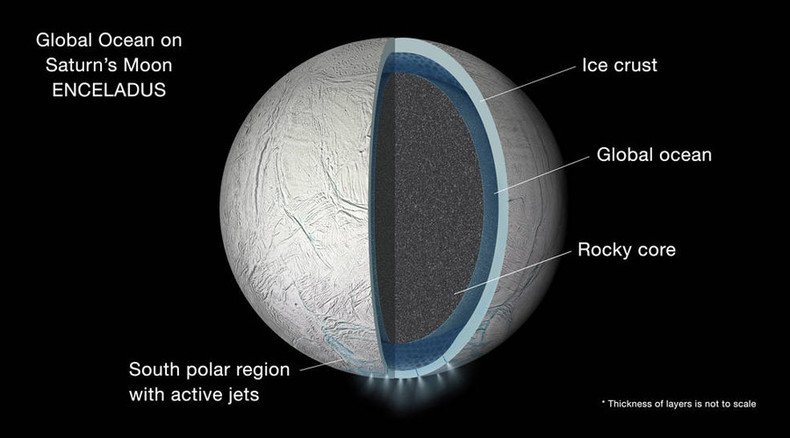Saturn moon has subsurface ocean that covers entire body – NASA

An ocean lies beneath the icy crust of Saturn’s moon Enceladus, overing the entire celestial body, according to new research data from NASA’s Cassini mission.
Although researchers have known about water on Enceladus, they used new images from Cassini to detect that the moon wobbles slightly as it orbited Saturn, and that could only be explained if its outer ice shell was not frozen solid to its interior. If not, that means a global ocean must be present.
“This was a hard problem that required years of observations, and calculations involving a diverse collection of disciplines, but we are confident we finally got it right,” said Peter Thomas, a Cassini imaging team member at Cornell University, and lead author of the paper, in a statement.
A global ocean! All the more reason for NASA to approve the #Enceladus Life Finder mission. http://t.co/VHZ9xt2Dxg
— Maddie Stone (@themadstone) September 16, 2015The Cassini spacecraft launched in 1997, and has been orbiting and photographing Saturn since mid-2004, a mission that has provided scientists with seven years’ worth of images. They’ve mapped the features of Enceladus, noting craters, to analyze the moon’s rotation, and that’s when the wobble or “libration” was discovered.
Enceladus is not perfectly spherical, which means sometimes it moves faster and slower during its orbit around Saturn.
"If the surface and core were rigidly connected, the core would provide so much dead weight the wobble would be far smaller than we observe it to be," said Matthew Tiscareno, a Cassini participating scientist at the SETI Institute and a co-author of the paper, in a NASA statement.
"This proves that there must be a global layer of liquid separating the surface from the core," he said.
New @CassiniSaturn data show Enceladus has a full ocean--not just a puny lake--under its ice. http://t.co/lwOfA6Q7x7pic.twitter.com/EqAcrYOFwG
— Corey S. Powell (@coreyspowell) September 15, 2015Why Enceladus’ ocean isn’t frozen remains a mystery for now. Thomas and his colleague suggest the possibility that tidal forces, due to Saturn’s gravity, could be generating more heat for the subsurface ocean.
NASA’s Cassini mission to Saturn has yielded great discoveries about Enceladus. Icy plumes were first detected in 2005, and that led to discoveries of material gushing from warm fractures near its south pole. Scientists announced strong evidence for a regional sea in 2014, and in 2015 they shared results indicating hydrothermal activity taking place on the ocean floor.
Dark side of Saturn: NASA releases new image of ringed planet at night
http://t.co/O5AJ3PXdpXpic.twitter.com/W0GFS0C2xm
— RT America (@RT_America) September 16, 2015Cassini is scheduled to make a close flyby of Enceladus on October 28, in the mission's deepest-ever dive through the moon's active plume of icy material. The spacecraft will pass a mere 30 miles (49 kilometers) above the moon's surface.
Enceladus isn’t the only moon in the solar system to harbor a subsurface sea. Titan, one of Saturn’s 60-plus moons, is believed to have a global ocean. There is also evidence of seas on the Jupiter moons of Callisto, Ganymede, and Europa.
Amazing details of Saturn & its moons captured by #NASAhttp://t.co/mqLxxpWcd8pic.twitter.com/eNiHSY5et0
— RT America (@RT_America) December 11, 2014












